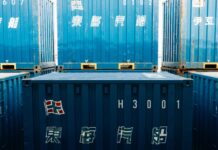
Shipping and logistics can be a time-consuming and challenging process that often results in headaches and misplaced orders.
A very efficient way to ship orders is using an FCL shipment or full container load.
FCL or full containers for single shipments means you’ll receive a container that is entirely yours. FCL cargo doesn’t share space with any other cargo. As such, it’s your responsibility to pay the complete fee for shipping goods in one go instead of instalments over time, as many companies do nowadays.
For some, the idea of a single shipment is limiting. But for those who can afford it and have plenty to ship—or are shipping something incredibly bulky or heavy like construction materials –this may be just what they need.
A full container will hold your goods exclusively; you won’t share this load with any other cargo on board. However, you’ll still shoulder all costs explicitly related to moving these enormous containers around from points A – B.
Choosing a service level
The first step in preparing an order for shipment is choosing the correct service level. There are three different levels of FCL shipments:
Unrestricted Service (USD)
This option provides for consolidated items to be shipped throughout the year, regardless of market conditions, with no extra fees. It will generally be the cheapest option because there are no seasonal restrictions.
Guaranteed Container Availability (GCA)
This option allows merchants to book their container 12 months in advance to lock in rates and avoid fluctuation due to seasonal demand.
Premium Service (USD)
This service guarantees delivery within three weeks after booking by allowing merchants to select specific days when their container will arrive.
Choosing container loading options
In addition to choosing a service level, merchants can also choose various options regarding how their items are packed into the container.
Loose Load
Packed in bulk and loaded loose onto a palette.
Block Loading
All similar-sized items are grouped and loaded as a block on a palette.
Palletized
Items that exceed the standard weight for a 20 or 40-foot container will be palletized and padded accordingly. A pallet including padding adds a layer of security in preventing damage during transit; this service is not automatically included in the price.
Determine the container capacity
Container capacity is not the same for all containers. The capacity of the container must be the weight and volume that you are shipping to get charged at a fair price.
In addition, some items may not fit into a container due to their size or shape, while others cost too much per pound to make sense in shipping them overseas by sea. Some goods may also have a high selling value, making it more advantageous for your business to sell them locally rather than send them abroad, where margins are reduced via transportation costs.
Filling out paperwork
After choosing a service level, merchants must complete a customs declaration with the shipment. This document provides all necessary information regarding the origin, destination and weight of goods being shipped.
In addition, a commercial invoice is required for every order that will be exported out of the country. It provides further insight into each item being purchased, including brand name and description – without this document, merchants may have difficulty clearing customs at their destination.
In some countries such as China, not having a commercial invoice included with the shipment can result in penalties or even imprisonment due to suspected fraud.
Shipping
Once an order has been received from the merchant, it is packaged and loaded onto a truck for delivery to domestic or international terminals. Airlines usually operate out of terminals to load their planes, while ocean carriers use marine terminals to load cargo onto ships.
All FCL shipments are loaded onto trucks for delivery to domestic or international terminals. The trucking company decides which terminal/airport the goods are loaded at. Upon arrival at the destination’s terminal, customs officials will finalize paperwork and authorize merchandise for delivery.
Delivery
Once an order has cleared customs, they can transfer it to your warehouse, where you can begin receiving inventory for distribution throughout your business. Your employees must know the location and inventory count of each received item from an FCL shipment. It is vital to ensure that all items are accounted for before being resold or utilized by your company.
More Shipping
After you have received your first container, filled with inventory, you can send it back to the shipper for another container to be shipped in its place. Before doing this, make sure that the goods you wish to ship will fit into a new container as not all containers are created equal. The shipper will pack it according to their guidelines.





